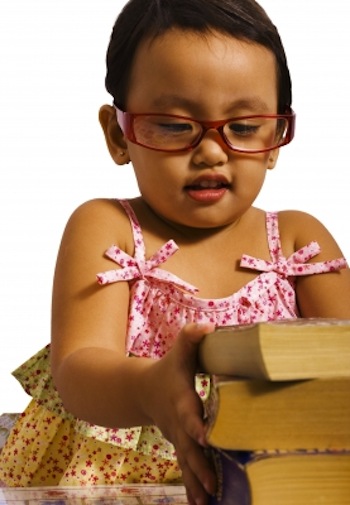Getting Your Kids’ Brains Geared Up for the School Year
The summer may not be winding down quite yet, but you want to make sure your kids’ school brains aren’t either. Use these fun activities to get their minds active and stimulated again. Get your kids’ brains geared up for the school year.
Get reading
Start a family list of books to read and have everyone participate. Then you can discuss favorite stories and authors. Hang a small whiteboard or chalkboard in the kitchen, with a few colorful markers or sticks of chalk. Keep the list running. When someone hears about a new book, they can add it to the list. Select a time to make a weekly trip to the library to check out a few from the board. Think of it as a family book club.
Summer camp
Scope out the educational camp scene in your area. Is there a space or archeology camp your little ones may be interested in? What about a young authors’ writing camp? Check with your kids’ school, community center or local library to see available camps in your town.
Bake a treat
Baking is a great way to keep busy, full and work on some math skills. For slightly older kids, measuring can be great for all sorts of math from adding and subtracting, to multiplying and dividing. For littler ones, baking is a good time to practice newfound counting skills.
Keep crafty
Crafts are the perfect way to both have fun and encourage an active imagination. Take advantage of the sunshine and nice weather by moving craft time outdoors. Plus, that means less mess indoors!
Sources:
-“5 Ways to Keep Your Kids’ Brains Active All Summer Long” Gaiam Life: http://life.gaiam.com/article/5-ways-keep-your-kids-brains-active-all-summer-long
-“Summer Brain Drain: How to Keep Sharp Over the Summer Break” Tutor Doctor: http://tutordoctor.com/blog/blog/summer-brain-drain-how-to-keep-sharp-over-the-summer-break/
-“25 Activities to Keep Kids’ Brains Active in Summer” Education World: http://www.educationworld.com/a_curr/profdev073.shtml
-Photo courtesy of stockimages/freedigitalphotos.net
Mommy Math: Reading and Singing to Children
While most experts agree that reading to children improves literacy and language skills later on in life, new studies show that singing also has a positive impact on children’s learning. MomTrusted put together this infographic on reading and singing to children. Check out how many parents read, tell stories and sing to their children of different ages:

Mommy Math: Children and Reading
Did you know that the amount of parents who read to their pre-kindergarteners daily has decreased by 5% in recent years? Yet college enrollment seems to be on the up-and-up or at least it was until 2010. MomTrusted digs into the statistics behind children and reading, from reading scores to college enrollment:
3 Ways to Help Your Child Reach Their Full Potential
With the job market in its current state, colleges getting more expensive and scholarships getting pickier and more difficult to obtain, the need to help your child reach their full potential is becoming increasingly important. The importance of outshining fellow classmates has become an obsession for many. We’ve put together a few steps to help your kiddos be as great as they can be without putting too much pressure on them:
Step 1: Talk to your child
Ask them questions from when they’re learning to talk to when they’re leaving for college. Ask them about their day. Ask their opinions. Ask about their goals. Throw in a few challenging vocab words when you’re asking these questions. Even if your little one doesn’t know exactly what they mean, he or she can use the context of the question to figure them out, teaching important problem solving skills.
Step 2: Read to your child
Reading stimulates parts of the brain that talking and playing don’t. It also helps grow children’s vocabulary pools and literacy. Keep plenty of books around the house and make sure to take fun trips to the library. Read aloud to them, but also encourage them to read on their own. Ask them what they’re reading about and teach by example by making sure you’re reading in front of them.
Step 3: Praise results, but don’t fuss over shortcomings.
Did your child ace a spelling quiz or learn a new word? Tell them how awesome that is! Don’t necessarily buy them a special toy or treat though. You want to make it clear that getting results is important in itself, not a way of getting presents.
However, don’t make a big deal out of a mistake or not coming in first. Failures are just another way of learning. Remind your child of the valuable lesson they’ve learned and ask them what they think they could do next time to improve. Doing this will set progression tools for the rest of their lives.
Sources:
-“How to Raise Gifted Children.” Parenting.com
-Photo courtesy of photo stock/freedigitalphotos.net
7 Ways to Promote Early Education
 It’s never too early to start actively enforcing your toddler’s learning, even before they head to preschool. Simple, every day activities promote early education, putting your child in peak learning shape for when they do head to school.
It’s never too early to start actively enforcing your toddler’s learning, even before they head to preschool. Simple, every day activities promote early education, putting your child in peak learning shape for when they do head to school.
Stick to a routine. Consistency is grounding and gives children a sense of trust. Once their environment is stable, they’ll be more open to learning, especially at an early age.
Hit the books early. Just because your child can’t read on their own quite yet, doesn’t mean they don’t love to read. Reading out loud can help jumpstart reading skills. Plus, reading to your little one helps build basic skills like speech, sentence structure and the abcs of learning (like reading from left to right).
Let them help with every day tasks. There are measuring lessons in cooking, color recognition in laundry and biology lessons in gardening. Learning every day tasks will not only teach responsibility and the jobs themselves, but there are mini lessons to be learned with each activity.
Participate. Joining in and guiding result in more effective learning than simply telling children what to do. Kids learn by example and, especially at young ages, often mirror their parents and teachers. They’ll learn faster if they have someone to observe and copy.
Communicate. Simply talking and listening to your child will help them learn. They want to both ask you questions and share their theories and experiences. Listen when they do and actively respond. If your child is telling you about coloring at a play date, ask what they drew and why they chose that subject. Talk about their favorite colors.
Encourage creativity. Youngsters learn by imagining and imitating through dress up and pretending. Encourage them to express themselves and make believe. These behaviors are their way of understanding and digesting the world around them.
Time and patience are key. Take things slow and one day at a time. Just like adults, children have good and bad days. It’s your job to remain consistent and loving, not frustrated. Plus, overstimulation is never good. A slow, steady pace gives your little one time to digest all of the new information they’re taking in.
Sources:
-Serge, Irene. “Time to Get Serious About Early Learning.” Eye on Early education. November 28, 2012. < http://eyeonearlyeducation.org/2012/11/28/time-to-get-serious-about-early-learning/>
-“10 Reasons Why You Should Read to Your Kids” Early Moments. < http://www.earlymoments.com/Promoting-Literacy-and-a-Love-of-Reading/Why-Reading-to-Children-is-Important/>
-“Promoting Learning.” BornLearning.org. http://www.bornlearning.org/default.aspx?id=17
-“Early Learning at Home and in Preschool.” 4Children.org. http://www.4children.org/issues/2012/spring/early_learning_at_home_and_in_preschool/
-Photo courtesy of sheelamohan/freedigitalphotos.net
Top Educational Books for Tots
Counting books
There’s a whole list of books out there that help kids learn their numbers.
- 1, 2, 3 to the Zoo by Eric Carle explores the magic of numbers as different animals pile on the train to head to the zoo. This story is meant for kids 2-4 years old.
- Counting Kisses by Karen Katz is a cute counting book for kids ages 0-4.
- How Do Dinosaurs Count to 10? by Jane Yolen, for kids 4-7 years old, uses rhymes to help teach readers how to count to 10.
- In David Kirk’s Miss Spider’s Tea Party, for 4-6 year-olds, Miss Spider attempts to squash her neighbors’ fear of her by throwing a tea party.
ABC books
ABC books like these teach children letter recognition:
- Pam Abrams’ Now I Eat My ABCs for tots 0-3 has a yummy food assigned to each letter of the alphabet. B is made of blueberries and O is an orange.
- I Spy Letters by Jean Marzolo lets 0-4 year-olds learn letters through rhyming and hand-painted letters.
- The classic Chicka Chicka Boom Boom by Bill Martin Jr. and John Archambault tells the story of a, b, c, d and e meeting at the top of a coconut tree.
Colors
Teach your little ones colors:
- Justine Smith’s Colors is filled with bright, bolds illustrations. This book is made for children 1-3.
- A kitten hunts for its favorite color in Cat’s Colors by Jane Cabrera.”Favorite
Shapes
Help toddlers learn their shapes:
- Every day objects in Justine Smith’s Shapes help kids 0-2 learn shapes. Plus, the rhyming words and colorful illustrations make learning fun.
Sources:
-“Educational Books for Toddlers.” Scholastic. http://www.scholastic.com/resources/article/educational-books-for-toddlers/
-“Favorite Books for Preschoolers.” Great Schools <http://www.greatschools.org/cgi-bin/showarticle/3607/>
-Photo courtesy of Stuart Miles/freedigitalphotos.net
Raising Bilingual Children
The percent of children who speak a language other than English at home has risen from 10% to 21% in the past three decades, according to the National Center for Education Statistics. The amount of bilingual kids is on the rise and, while it’s actually been proven that older children may have an advantage when learning a second language, it never hurts to begin early. Starting off with more than one language as a baby will not slow progress of language in any way and will only advance memorization and problem solving skills. Here are some helpful tips for raising bilingual children:
Learn with them.
If you don’t already speak the second language you’re introducing to your child, this is your opportunity to learn too. They better you understand what you expect your little one to learn, the more thorough job you can do teaching them.
Start small.
Don’t feel like you need to be a pro and start speaking half in English and half in the chosen language. Start by throwing in a couple bedtime books in Spanish. Or sing simple, children’s French songs in the car. Adding small splashes of the secondary language will help teach your toddler basic vocabulary and concepts, the first start to raising a bilingual child.
Hire bilingual help.
Need a babysitter or nanny? Consider hiring one who speaks a second language and request that they communicate with your kids using that language at least 50% of the time. This is a great approach because it incorporates handy, everyday activities with the new vocabulary, making it easier to learn the familiar actions.
Take a vacation.
If affordable, travel to a country that speaks the language your child is learning. This is an especially great option as children get older and learn social skills. It will give them the opportunity to use their new language while making new friends.
Sources:
-Lowry, Lauren. “Bilingualism in Young Children: Separating Fact from Fiction.” The Hanen Center.
-“Raising bilingual kids: benefits and techniques.” PHD in Parenting.
-“ Fast Facts: English Language Learners.” National Center for Education Statistics.
-Paturel, Amy. “A Guide to Raising Bilingual Children.” Parenting.com
-Photo courtesy of Phaitoon/freedigitalphotos.net
















